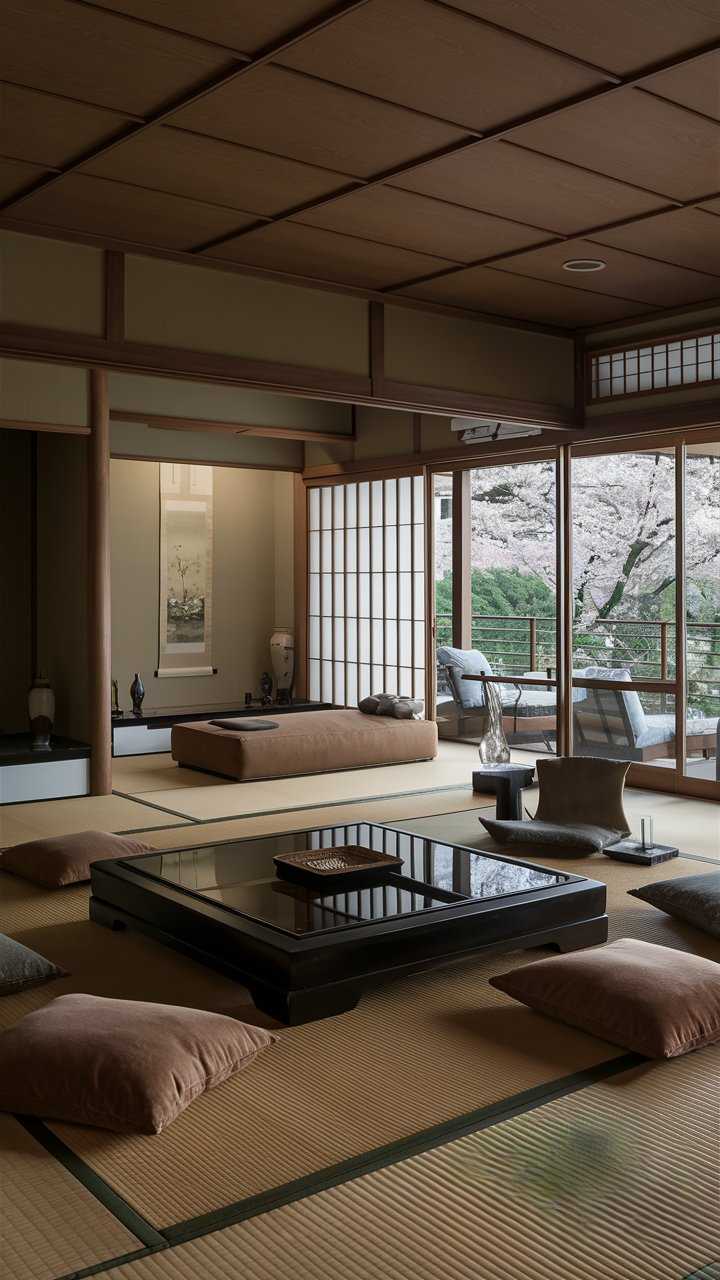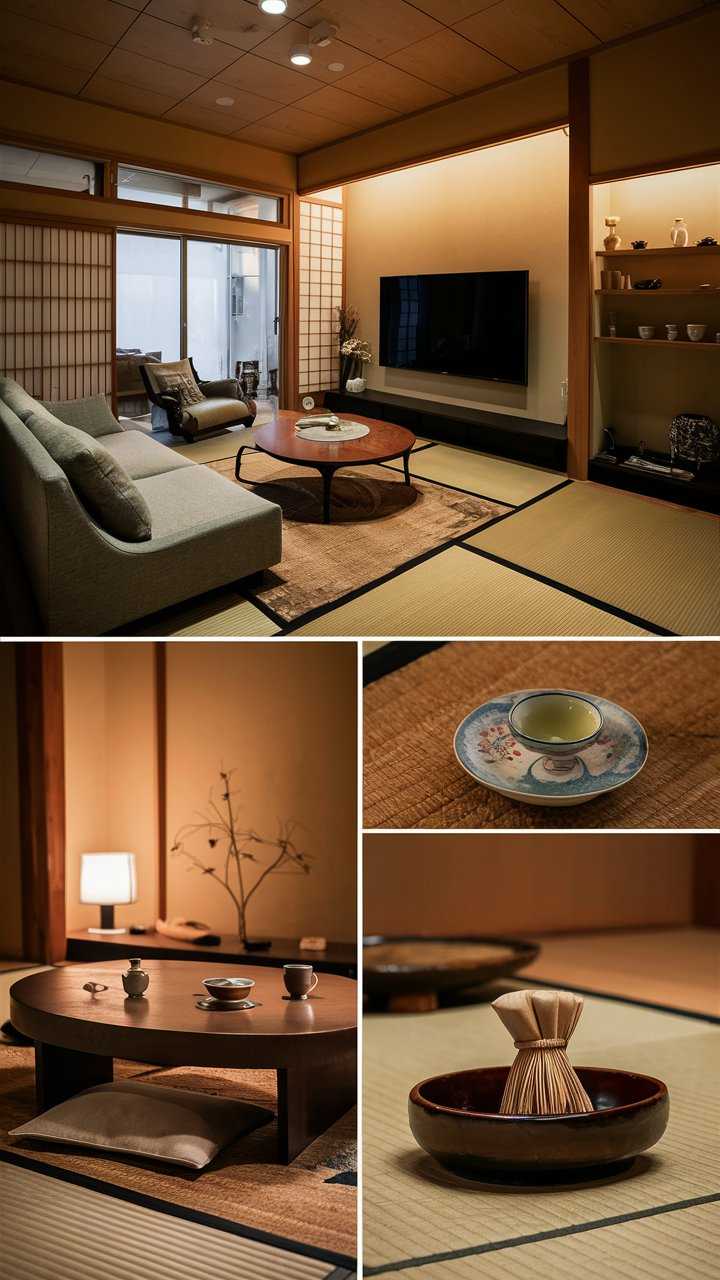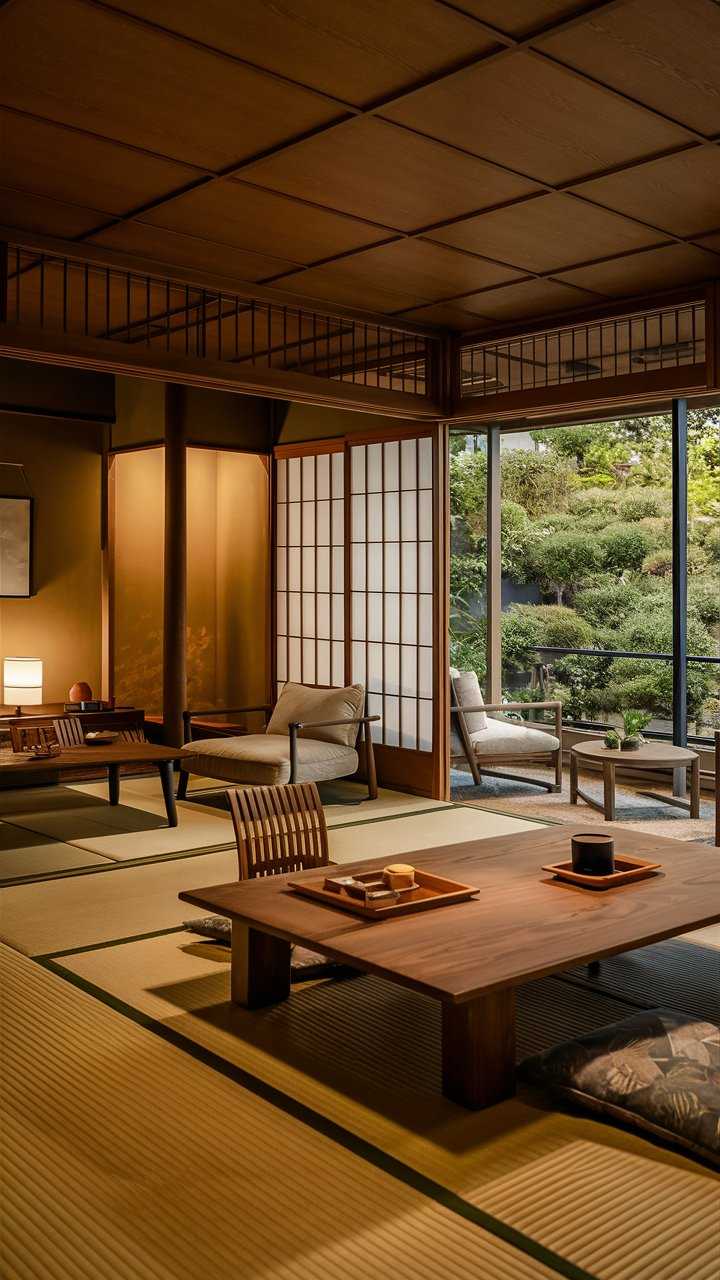Traditional Japanese Living Room Design Ideas
Creating a Japanese living room is like an art form. It mixes zen simplicity with practicality. This style brings peace into your home, making every part of the room work together for calmness. Tatami mats and shoji screens are key to this look, adding elegance and a minimalist vibe.
By using these traditional pieces, you can make a peaceful living area. It shows the beauty of Japanese culture.
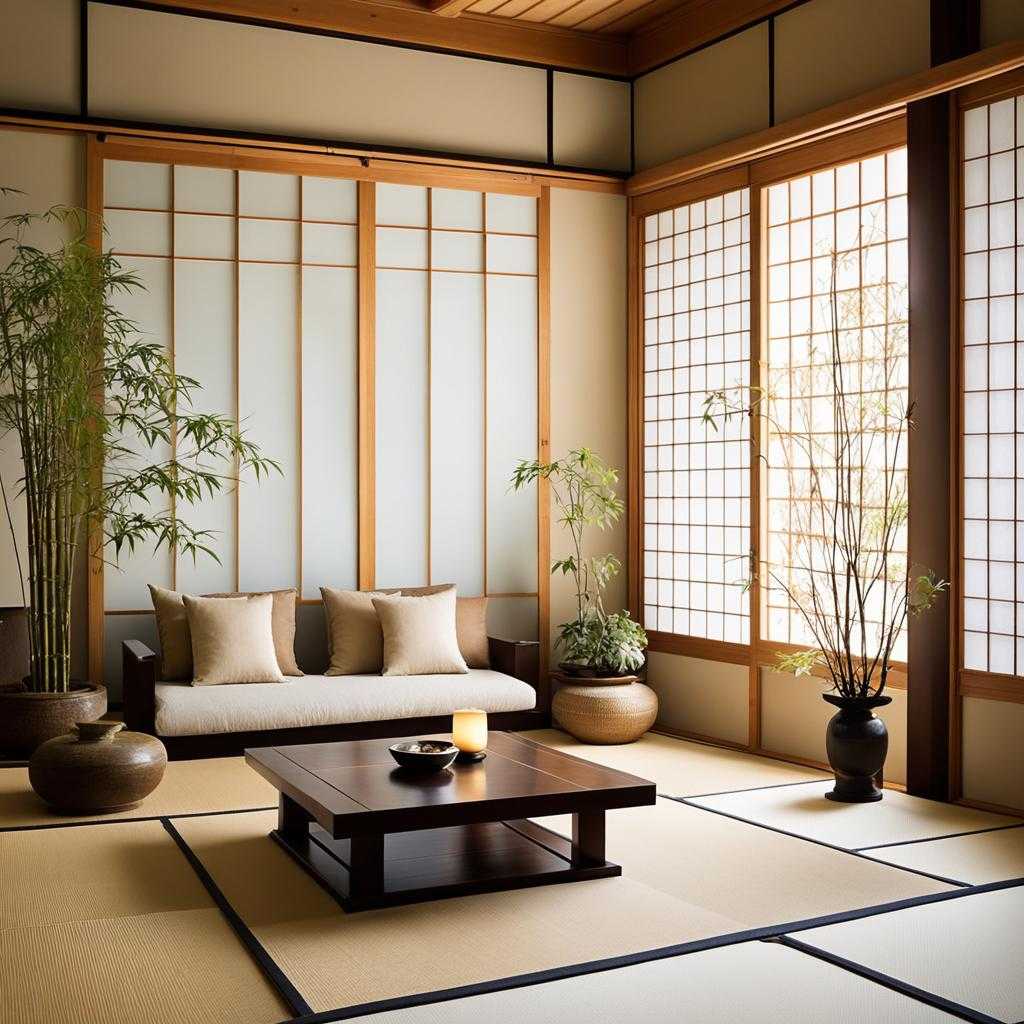
Key Takeaways
- Understanding the key characteristics of Japanese living room design can enhance home tranquility.
- Tatami mats are essential for authenticity, offering unique texture and warmth.
- Shoji screens provide both elegance and functionality in space division.
- Minimalism is at the heart of Japanese aesthetics, promoting a clutter-free environment.
- Incorporating natural materials fosters a continuous connection with nature.
Understanding the Basics of Japanese Style Living Rooms
Creating a Japanese living room means embracing the core principles of this serene style. At the heart is zen simplicity. Each piece is chosen to add beauty without crowding the space. This focus on simplicity makes the room both functional and beautiful.
Natural materials like wood, bamboo, and textiles are key in Japanese design. They bring the outdoors in and make the space feel warm and welcoming. Big windows or sliding doors let in lots of natural light and often show off gardens, adding to the peaceful feel.
Low furniture, such as cushions or tables, is common in Japanese rooms. It encourages a feeling of being close to the ground. The design also values open space for easy movement and a calm, meditative feel. Soft, earthy colors are used to create a soothing look that matches the natural surroundings.
Following these design tips creates a peaceful space that embodies zen simplicity. It’s a place where minimalism meets beauty, making it perfect for relaxing and thinking deeply.
Key Elements of Japanese Living Room Design

In traditional Japanese aesthetics, a living room is simple and serene, connected to nature. Natural materials and minimalist decor are key to creating this peaceful space.
Furniture like futons and traditional wood pieces is low to the ground. This design helps people feel connected to the earth. Tatami mats, made from rice straw, add texture and show the value of natural materials.
Decor should be simple yet functional. A beautiful watercolor wallpaper with floral patterns can bring calm. It connects the indoors with nature, making the space more magical.
Balance is crucial for the right look. Furniture should be placed thoughtfully to keep the space calm. A few special items, like ceramics or calligraphy, can add beauty without being too much.
By using these elements, you create a space that reflects traditional Japanese beauty. It becomes a peaceful place that lasts over time.
Incorporating Tatami Mats for Authenticity
Tatami mats are key to making a Japanese living room traditional look. They bring a real feel with their unique texture and natural materials. This section talks about the benefits of tatami mats in design and how to keep them looking great.
Benefits of Tatami Mats in Design
Tatami mats bring many advantages to a room:
- Comfort: They are soft and cushioned, making the space cozy.
- Aesthetic Appeal: Their look adds character and makes the room feel more authentic.
- Natural Material: Made from rice straw and rush grass, they are a sustainable choice.
- Insulation: Tatami mats help keep the room at a good temperature.
- Sound Absorption: They make the room quieter by absorbing sounds.
Care and Maintenance of Tatami Mats
To keep tatami mats looking good and lasting longer, follow these care tips:
- Regular Cleaning: Use a vacuum with a soft brush to clean without damaging the mat.
- Spot Cleaning: For spills, dab with a damp cloth and mild soap, but don’t soak it.
- Avoid Moisture: Keep mats dry to stop mold and mildew; don’t let them get too wet.
- Rotate Mats: Turn the mats often to wear them evenly and let them get sunlight.
- Protection: Use coasters or area rugs in busy spots to reduce wear and tear.
| Feature | Tatami Mats | Other Floorings |
|---|---|---|
| Material | Natural rice straw and rush | Varies (wood, vinyl, carpet) |
| Comfort Level | High | Moderate to High |
| Sound Absorption | Excellent | Poor to Moderate |
| Eco-Friendliness | High | Varies |
| Maintenance | Low | Moderate to High |
The Role of Shoji Screens in Space Division
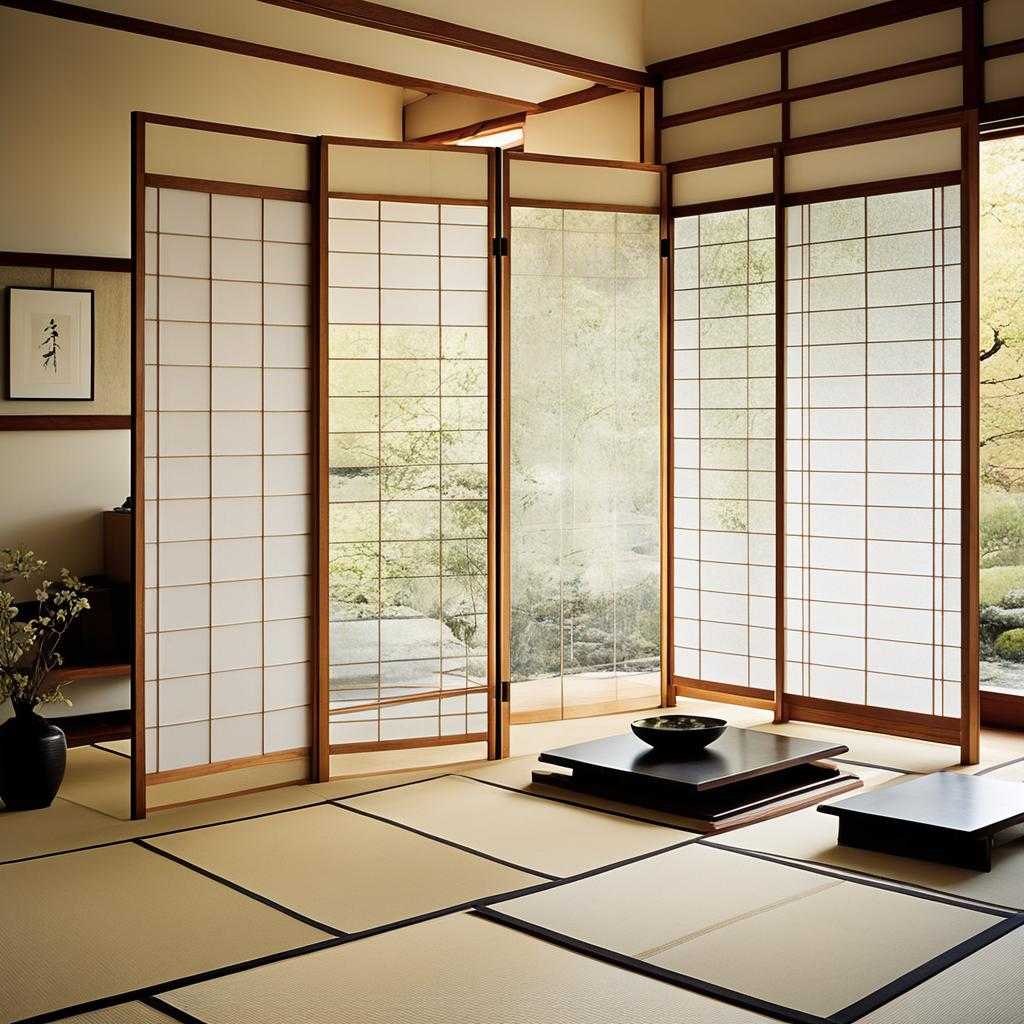
Shoji screens are key in dividing space in Japanese living rooms. They are known for their fine craftsmanship. These screens help keep things private but still let in light, making the space feel open and calm. They’re perfect for relaxing or hanging out with others.
Different Styles of Shoji Screens
Shoji screens have many styles to match any room’s look. Here are some top choices:
| Style | Description |
|---|---|
| Traditional Shoji | Made from wooden frames with rice paper, offering a classic aesthetic. |
| Modern Shoji | Uses glass or acrylic for a modern look but still divides space. |
| Sliding Shoji | Has sliding parts for easy room setup and access. |
| Decorative Shoji | Features unique patterns or colors, making a room stand out. |
Adding shoji screens to Japanese living rooms boosts both looks and function. They’re great for dividing space in ways that work for everyday life. They keep the room’s cultural feel while being practical.
Exploring different shoji screen designs can spark new ideas for your space. Arranging furniture with shoji screens creates a peaceful setting. It’s like the cozy, welcoming kitchens found here.
Minimalism: The Essence of Japanese Aesthetics
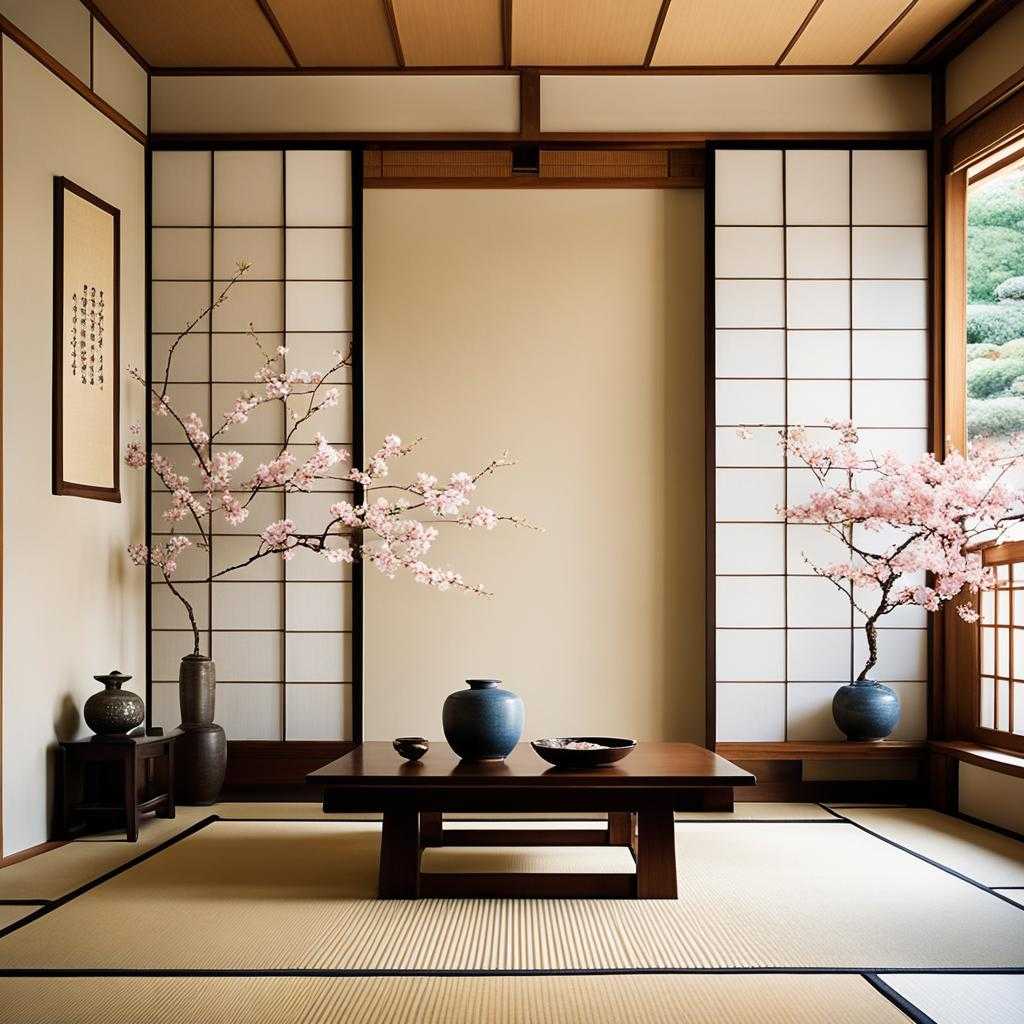
The idea of minimalist decor in Japanese living rooms is all about zen simplicity. It’s not just about getting rid of clutter. It’s about choosing each item carefully to make the space peaceful and calm.
In a minimalist space, finding balance and harmony is key. You’ll see things like:
- Natural materials like wood and bamboo, which connect us to nature.
- Neutral colors that make the space calm.
- Lighting that highlights the beauty of simplicity.
This careful design creates a place for relaxation and thinking deeply. By focusing on zen simplicity, people can make a space that helps them be mindful and less distracted. This way, they can enjoy the true beauty of a Japanese living room traditional style. Minimalism becomes a way of life, not just a look.
Creating Quiet Moments with Tokonoma Alcoves
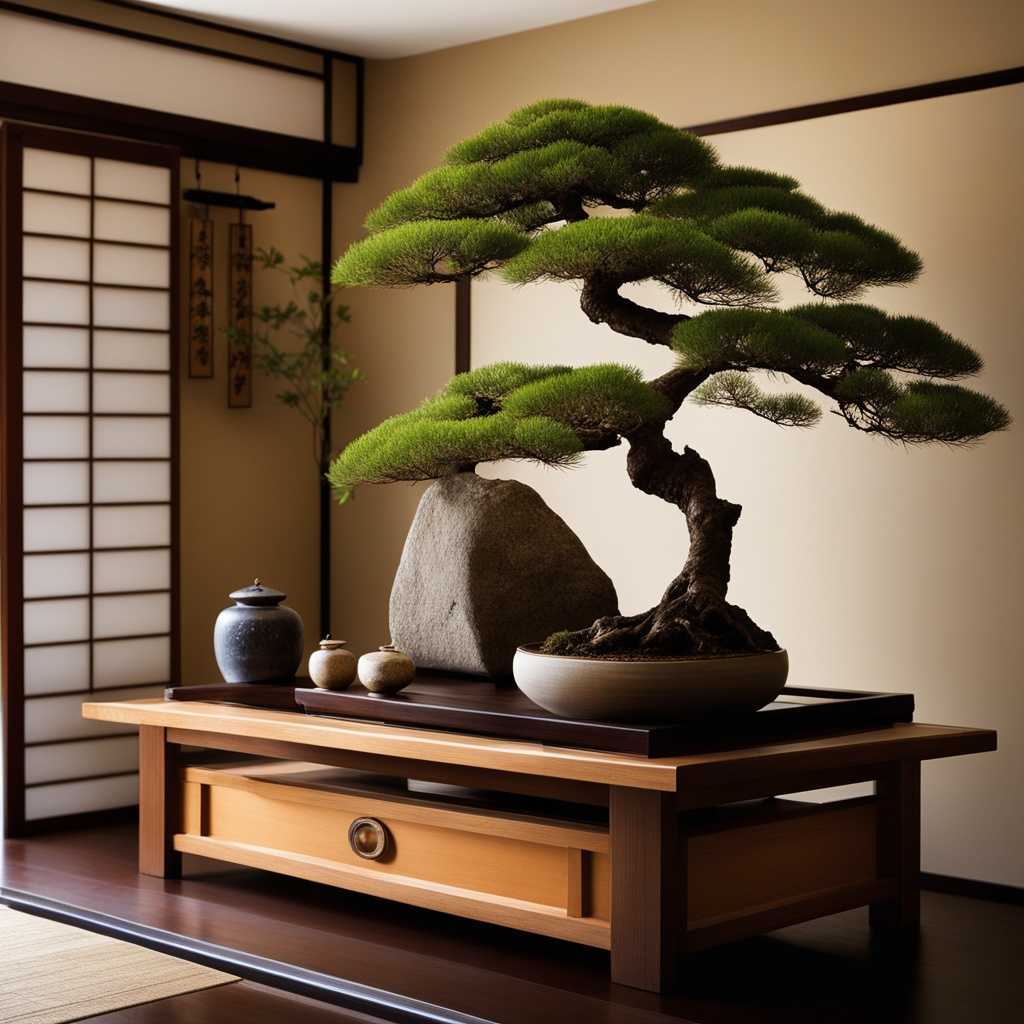
The tokonoma alcove is a key part of traditional Japanese decor. It’s a place to show off art and flowers. This special spot makes a Japanese living room feel calm and inviting. By choosing the right items for the tokonoma, you can show off your artistic side while keeping things simple.
How to Decorate a Tokonoma
Decorating a tokonoma needs careful thought. Here are some tips:
- Calligraphy Scrolls: A beautiful scroll can add culture and depth. Pick themes that mean something to you or match the season.
- Ikebana Arrangements: Ikebana uses flowers in a simple yet elegant way. Choose blooms that are in season to add color and life.
- Natural Elements: Adding stone or wood brings a natural touch. Look for pieces that are both rustic and elegant.
- Lighting: Soft lighting can make the decor glow. Think about lights you can adjust to set the mood.
Each item in the tokonoma creates a peaceful spot. It invites people to stop and think. Paying attention to details makes a space that feels truly Japanese. This adds to the beauty of a Japanese living room.
| Element | Purpose | Material Suggestions |
|---|---|---|
| Calligraphy Scrolls | Adds cultural depth | Silk, Paper |
| Ikebana Arrangements | Brings natural beauty | Seasonal flowers, Greenery |
| Natural Elements | Enhances organic feel | Wood, Stone |
| Lighting | Creates soothing ambiance | Paper lanterns, Soft LED lights |
Japanese Living Room Traditional Touches
Adding traditional decor items to a Japanese living room makes it more special. Things like wooden carvings, pottery, and handwoven textiles bring life to the room. They show off Japan’s rich culture and craftsmanship.
The wabi-sabi aesthetic is key to this look. It’s all about finding beauty in things that are a little imperfect. Choosing items with unique features, like a bowl with a slight curve, adds character. These pieces have stories to tell.
Arranging these traditional decor items thoughtfully makes the room feel warm and inviting. Showing off family treasures or old pieces connects the past to today.
Some top traditional touches to think about are:
- Authentic wooden furniture
- Handcrafted pottery
- Textiles with natural fibers
- Calligraphy scrolls
- Seasonal decor reflecting nature
Putting these traditional elements together creates a peaceful space. It’s a mix of beauty and history. This makes a Japanese living room traditional that’s both cozy and culturally deep.
Choosing the Right Color Palette for Serenity
Creating a calm space in a Japanese living room means picking the right colors. Earthy tones, inspired by nature, are key for a peaceful feel. Colors like soft greens, warm browns, and gentle neutrals bring in the natural world’s calmness.
These colors make the space welcoming, perfect for relaxing and being mindful.
Earthy Tones and Their Psychological Effects
Earthy tones deeply affect our feelings, bringing a sense of grounding. In a Japanese living room, they connect us to nature, making the space peaceful. By choosing colors that match Japanese design, we create a space that encourages calmness.
Use of Natural Light in Color Selection
Natural light changes how we see colors in a room. In a Japanese living room, picking the right window treatments is crucial. They let in light while keeping the color palette intact.
This mix of light and color boosts the calm feel and makes the room seem bigger and more open. Using light smartly turns simple colors into a stunning atmosphere, making the room more tranquil.



